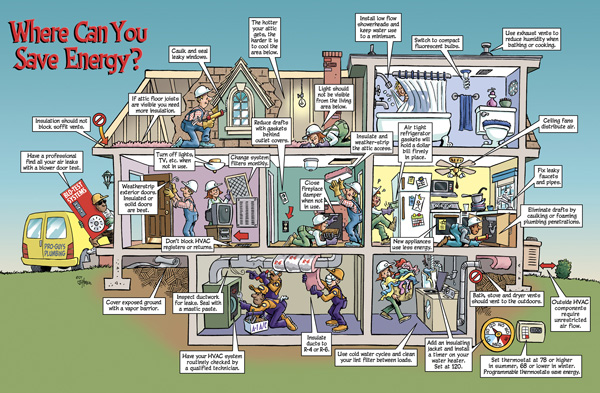| Create a Free Account or Sign In to connect and share in green living and alternative energy forum discussions. |
Energy: Saving Tips
Views: 944
Mar 05 2012 03:40 AM | eds in Ed's Articles
 Reducing your Heating & Cooling costs:
Reducing your Heating & Cooling costs:WEATHERIZE & INSULATE
Heating and cooling costs account for 1/2 or more of a typical home’s total energy bill
- Properly caulking and weatherstripping your doors and windows can reduce heating and air conditioning usage by 10 to 20 percent.
- Weatherstrip your attic access door and insulate this door by attaching foam insulation or fiberglass batting to the back. Adequate insulation in your attic, ceilings, exterior and basement walls, floors, and crawlspaces, can save you up to 25% on home energy bills.
- Clean warm-air registers, baseboard heaters, and radiators as needed; make sure furniture, carpeting, or drapes do not block them.
- Glass fireplace doors help stop heat from being lost up the chimney. Also, close the fireplace damper when not in use.
- In the winter, the air is normally dry inside your house. This is a disadvantage because, to be comfortable in dry air, people typically require a higher temperature than they would in a humid environment. Therefore, efficient humidifiers are a good investment for energy conservation.
IMPROVE YOUR APPLIANCES & ELECTRONICS
Households that replace existing equipment with ENERGY STAR qualified products can cut annual energy bills by more than $500 per year.
Replacing an old refrigerator (18 years or older) with a new unit reduces electric usage by at least 35%. Because they are more efficient than standard models, ENERGY STAR® units will lower refrigeration energy usage even more – by over 45%.
- The average home has 2 televisions, a VCR, a DVD player and 3 telephones. If these items were replaced with ENERGY STAR qualified models, it would save more than 25 billion pounds of greenhouse gas emissions, the equivalent of taking 3 million cars off the road for a year.
- If every U.S. household replaced just one incandescent bulb with an ENERGY STAR qualified fluorescent bulb, it would save enough energy to light 7 million homes and save $600 million in utility bills.
IMPROVE YOUR WINDOWS
- If your home has only single pane windows, consider replacing them with low-e coated or ENERGY STAR windows
- . . . or, storm windows can reduce your winter heat loss,
- . . . or you can improve your windows with plastic sheeting.
IMPROVE YOUR MECHANICAL SYSTEMS
If just 10% of U.S. households replaced their old heating and cooling equipment with an ENERGY STAR qualified model, and ensured that it was sized and installed properly, it would prevent the equivalent emissions of more than 17 billion pounds of greenhouse gases.
- Have your heating system tuned and cleaned yearly for best efficiency. Fuel savings can range from 5% to 10 %. For additional savings, clean or replace air filters in your forced air heating system once a month or as needed. An ENERGY STAR qualified furnace will use about 15% less energy than a standard model.
- About 15% of an average home energy bill goes to heating water. To save hot water, take 5-minute showers instead of baths. Do only full loads when using the clothes washer or dishwasher. Use cold water for laundry and save up to $63 a year – detergents formulated for cold water get clothes just as clean.
- Set your water heater thermostat at 120 degrees (or “low”). It’s hot enough for most needs – including dishwashers, which are generally made with booster heaters – and it cuts down on energy needed to keep water hot in the tank. Lowering your water heater temperature setting from 140 F to 120 F can reduce your water heating energy bill by over 10%.
- Install a programmable thermostat. Programming your thermostat from 72 degrees to 65 degrees for eight hours a day while no one is home, or while everyone is tucked in bed, will cut your heating bill up to 10 percent.
LANDSCAPE save $100-$250 each year
- Trees that lose their leaves in the fall give protection from the summer sun and permit winter sunlight to reach and warm your home. Plant trees on the south, east, and/or west sides of your home. Be sure to shade the AC unit. Create a windbreak with evergreen trees and shrubs to stop chilling wind.

